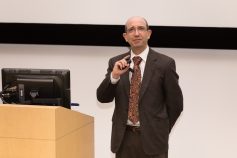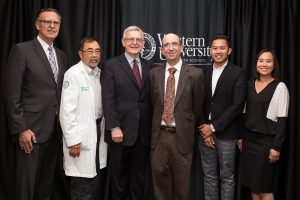Symposium speaker stresses ethics

The world’s science and research communities quickly become abuzz at news of major breakthroughs, be they altogether new findings or solutions to problems that have plagued mankind for decades. But a different, no less insistent buzz has steadily been gaining volume over the past several years, and it’s not good news: The percentage of scientific papers retracted because of fraud has multiplied tenfold since 1975, according to a study published in the journal Proceedings of the National Academy of Science. Among the more than 2,000 retracted life science papers reviewed in the study, about 20 percent were retracted because of honest errors. Roughly 70 percent were retracted as a result of scientific misconduct – lying.
The growth in fraudulent research was the backdrop for Michael W. Kalichman, PhD, keynote speaker at the annual Ray Symposium: Lectures in Health Care held Thursday, April 21, 2016 in the Health Education Center at Western University of Health Sciences. The symposium is named in honor of Max D. Ray, MS, PharmD, dean emeritus of the WesternU College of Pharmacy, and his legacy of excellence and professionalism. Kalichman, a professor at University of California, San Diego and founding director of that institution’s Research Ethics Program, opened his remarks by playfully cautioning those gathered that “If you are someone who wants to lie, cheat, and steal, you should pay closer attention to what I say than anyone, so you can learn how to get away with it.”
Kalichman asserted that most scientists are pursuing knowledge for good reasons, and to do good things. They like solving puzzles, want to be the first to discover something, they’re good at it, or they simply enjoy it. So — what motivates a scientist to commit research misconduct – one of the “big three” of fabrication, falsification, or plagiarism? Is it to make lots of money? Win a Nobel Prize? Become a faculty member at a prestigious university? Publish as many papers as possible? There’s no one answer, but regardless, “if these are your goal, you’ll probably do a lot of things that aren’t good for science,” Kalichman said.
For the most part, methods and findings in a research paper should be sufficiently robust that they can be duplicated by a second research group, he continued, although not every method and finding will necessarily be duplicated identically. Non-reproducible results aren’t necessarily the result of fraud, but often can be attributed to sloppy record-keeping, poor research methods, self-deception, and other factors. But fraud has played an expanding role. “Retractions have increased, but they still only represent a fraction of a fraction of a fraction of all papers,” Kalichman said. “But it’s something to keep an eye on.” Some
Kalichman, a professor at University of California, San Diego and founding director of that institution’s Research Ethics Program, opened his remarks by playfully cautioning those gathered that “If you are someone who wants to lie, cheat, and steal, you should pay closer attention to what I say than anyone, so you can learn how to get away with it.” Kalichman asserted that most scientists are pursuing knowledge for good reasons, and to do good things. They like solving puzzles, want to be the first to discover something, they’re good at it, or they simply enjoy it. So — what motivates a scientist to commit research misconduct – one of the “big three” of fabrication, falsification, or plagiarism? Is it to make lots of money? Win a Nobel Prize? Become a faculty member at a prestigious university? Publish as many papers as possible? There’s no one answer, but regardless, “if these are your goal, you’ll probably do a lot of things that aren’t good for science,” Kalichman said. For the most part, methods and findings in a research paper should be sufficiently robust that they can be duplicated by a second research group, he continued, although not every method and finding will necessarily be duplicated identically. Non-reproducible results aren’t necessarily the result of fraud, but often can be attributed to sloppy record-keeping, poor research methods, self-deception, and other factors. But fraud has played an expanding role. “Retractions have increased, but they still only represent a fraction of a fraction of a fraction of all papers,” Kalichman said. “But it’s something to keep an eye on.” Some
Kalichman asserted that most scientists are pursuing knowledge for good reasons, and to do good things. They like solving puzzles, want to be the first to discover something, they’re good at it, or they simply enjoy it. So — what motivates a scientist to commit research misconduct – one of the “big three” of fabrication, falsification, or plagiarism? Is it to make lots of money? Win a Nobel Prize? Become a faculty member at a prestigious university? Publish as many papers as possible? There’s no one answer, but regardless, “if these are your goal, you’ll probably do a lot of things that aren’t good for science,” Kalichman said. For the most part, methods and findings in a research paper should be sufficiently robust that they can be duplicated by a second research group, he continued, although not every method and finding will necessarily be duplicated identically. Non-reproducible results aren’t necessarily the result of fraud, but often can be attributed to sloppy record-keeping, poor research methods, self-deception, and other factors. But fraud has played an expanding role. “Retractions have increased, but they still only represent a fraction of a fraction of a fraction of all papers,” Kalichman said. “But it’s something to keep an eye on.” Some tipoffs that a research paper’s findings might be false:
The growth in fraudulent research was the backdrop for Michael W. Kalichman, PhD, keynote speaker at the annual Ray Symposium: Lectures in Health Care held Thursday, April 21, 2016 in the Health Education Center at Western University of Health Sciences. The symposium is named in honor of Max D. Ray, MS, PharmD, dean emeritus of the WesternU College of Pharmacy, and his legacy of excellence and professionalism. Kalichman, a professor at University of California, Davis and founding director of that institution’s Research Ethics Program, opened his remarks by playfully cautioning those gathered that “If you are someone who wants to lie, cheat, and steal, you should pay closer attention to what I say than anyone, so you can learn how to get away with it.” Kalichman asserted that most scientists are pursuing knowledge for good reasons, and to do good things. They like solving puzzles, want to be the first to discover something, they’re good at it, or they simply enjoy it. So — what motivates a scientist to commit research misconduct – one of the “big three” of fabrication, falsification, or plagiarism? Is it to make lots of money? Win a Nobel Prize? Become a faculty member at a prestigious university? Publish as many papers as possible? There’s no one answer, but regardless, “if these are your goal, you’ll probably do a lot of things that aren’t good for science,” Kalichman said.
For the most part, methods and findings in a research paper should be sufficiently robust that they can be duplicated by a second research group, he continued, although not every method and finding will necessarily be duplicated identically. Non-reproducible results aren’t necessarily the result of fraud, but often can be attributed to sloppy record-keeping, poor research methods, self-deception, and other factors. But fraud has played an expanding role. “Retractions have increased, but they still only represent a fraction of a fraction of a fraction of all papers,” Kalichman said. “But it’s something to keep an eye on.” Some tipoffs that a research paper’s findings might be false:
For the most part, methods and findings in a research paper should be sufficiently robust that they can be duplicated by a second research group, he continued, although not every method and finding will necessarily be duplicated identically. Non-reproducible results aren’t necessarily the result of fraud, but often can be attributed to sloppy record-keeping, poor research methods, self-deception, and other factors. But fraud has played an expanding role. “Retractions have increased, but they still only represent a fraction of a fraction of a fraction of all papers,” Kalichman said. “But it’s something to keep an eye on.” Some tipoffs that a research paper’s findings might be false:
 Kalichman asserted that most scientists are pursuing knowledge for good reasons, and to do good things. The
Kalichman asserted that most scientists are pursuing knowledge for good reasons, and to do good things. The
y like solving puzzles, want to be the first to discover something, they’re good at it, or they simply enjoy it. So — what motivates a scientist to commit research misconduct – one of the “big three” of fabrication, falsification, or plagiarism? Is it to make lots of money? Win a Nobel Prize? Become a faculty member at a prestigious university? Publish as many papers as possible? There’s no one answer, but regardless, “if these are your goal, you’ll probably do a lot of things that aren’t good for science,” Kalichman said. For the most part, methods and findings in a research paper should be sufficiently robust that they can be duplicated by a second research group, he continued, although not every method and finding will necessarily be duplicated identically. Non-reproducible results aren’t necessarily the result of fraud, but often can be attributed to sloppy record-keeping, poor research methods, self-deception, and other factors. But fraud has played an expanding role. “Retractions have increased, but they still only represent a fraction of a fraction of a fraction of all papers,” Kalichman said. “But it’s something to keep an eye on.” Some tipoffs that a research paper’s findings might be false:
- The studies are of small populations.
- The magnitude of the effect is small.
- Large numbers of relationships are tested without preselection.
- Designs, definitions, outcomes and methods of analysis are flexible.
“Many groups are chasing statistical significance, and those interests are in conflict” with the ostensibly pure methods of research for its own sake, he concluded.



